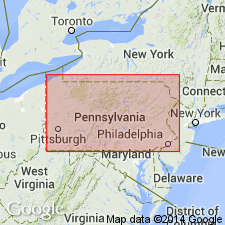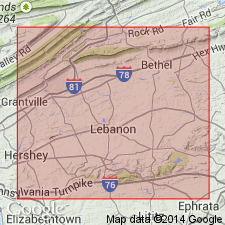
- Usage in publication:
-
- Jonestown beds, formation
- Modifications:
-
- Named
- Dominant lithology:
-
- Shale
- Limestone
- AAPG geologic province:
-
- Appalachian basin
Summary:
Named the Jonestown beds of the Martinsburg formation or Jonestown formation of Martinsburg group for Jonestown, Lebanon Co., east-central PA. Consists of basically dark shale weathering to buff chips that includes many red shale bands and lenticular bodies of platy or brecciated, rarely massive, limestone. Alternation of dark shale, red shale, and limestone is not sharply defined below, but passes over into non-red, limestone poor, older shales of the Martinsburg. Maximum thickness is 500 feet. Underlies the Shochary sandstone. The Jonestown is of Late Ordovician age.
Source: GNU records (USGS DDS-6; Reston GNULEX).

- Usage in publication:
-
- Jonestown volcanics
- Modifications:
-
- Redescribed
- Revised
- Dominant lithology:
-
- Volcanics
- Shale
- Sandstone
- Limestone
- AAPG geologic province:
-
- Appalachian basin
Summary:
Revised the Jonestown to the Jonestown volcanics [member] of the Martinsburg formation in central PA and redescribed it to consist of volcanics interbedded with series of shale, sandstone, and limestone. Section includes (ascending) dark-gray shale, green arkosic sandstone, and thin beds of red shale; red basalt breccia, massive basalt and some porphyritic basalt (about 600 feet thick); dark-gray shale containing beds of red and purple shale, green arkosic sandstone, and thin limestone (about 125 feet thick); hard white sandstone with angular fragments of green clay (about 150 feet thick); dark-gray shale with thin beds of red, purple, and green shale (about 50 feet thick); dark-greenish-gray basalt breccia, massive basalt, and amygdaloidal basalt (about 500 feet thick); fine- to medium-grained blue-gray limestone (about 150 feet thick); and dark-gray to black fissile shale. Stratigraphic position of volcanics is within main body of Martinsburg formation.
Source: GNU records (USGS DDS-6; Reston GNULEX).
For more information, please contact Nancy Stamm, Geologic Names Committee Secretary.
Asterisk (*) indicates published by U.S. Geological Survey authors.
"No current usage" (†) implies that a name has been abandoned or has fallen into disuse. Former usage and, if known, replacement name given in parentheses ( ).
Slash (/) indicates name conflicts with nomenclatural guidelines (CSN, 1933; ACSN, 1961, 1970; NACSN, 1983, 2005, 2021). May be explained within brackets ([ ]).

